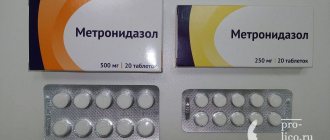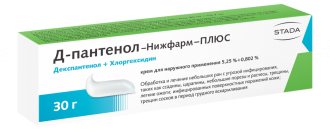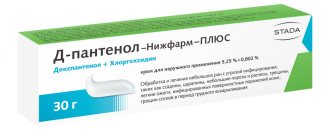The term “antibacterial chemotherapy” refers to the use of chemical compounds prescribed for infectious diseases and causing the death of their pathogens without damaging host tissues.
Unfortunately, many of the drugs developed in the 40-60s have now largely lost their clinical significance, which is due to the evolution of microorganisms and the emergence of their resistance to antibiotics.
This biological phenomenon - antibiotic resistance - determines both the tactics of therapy and the directions of activity of the pharmaceutical industry, which is forced to produce ever new antibacterial drugs, as well as the directions of scientific research to find new groups of drugs that are more effective for treating wound infections.
Wound infection occupies one of the leading places in the general structure of surgical morbidity.
Purulent-inflammatory processes are observed in 35% - 45% of surgical patients. Infection is the cause not only of various surgical diseases, but also of numerous postoperative complications: from suppuration of the postoperative wound to the development of surgical sepsis, which often leads to the death of the patient.
The reasons for the increase in the frequency and course of purulent infection in surgery are diverse and include the following factors: an increase in the volume of surgical interventions, especially in patients at risk, the widespread use of instrumental examination and treatment methods, accompanied by infection of the patient (intravascular and urinary catheters, endotracheal tubes, endoscopic manipulations etc.), the spread of antibiotic-resistant strains of microorganisms. These factors, as well as the irrational use of antibiotics, have led to an increase in the frequency of nosocomial infections caused by multidrug-resistant opportunistic pathogens.
More than half of all antibiotics currently used in the world are betalactams (penicillins, cephalosporins, cephamycins, carbapenems, monobactams).
Data from bacteriological studies conducted in various clinics indicate that pathogenic microorganisms have acquired resistance to long-term antibacterial drugs used in practice (penicillin, streptomycin, ampicillin, amoxicillin, cefazolin, etc.).
The most significant mechanism for the formation of resistance to betalactam antibiotics is the production of betalactamases by bacteria - approximately 80% of cases of resistance of both gram-positive and gram-negative microorganisms are associated with it, which is one of the main reasons for the declining effectiveness of many traditional antibacterial drugs for every hospital.
One of the ways to overcome antibiotic resistance is the use of betalactamase inhibitors in combination with penicillins or cephalosporins as part of combination drugs. Based on the betalactamase inhibitor clavulanic acid, a combination drug amoxicillin/potassium clavulanate was created, based on the betalactamase inhibitor sulbactam, combined drugs ticarcillin/clavulanic acid, ampicillin/sulbactam, cefoperazone/sulbactam were created, and piperacillin/tazobactam was created based on the betalactamase inhibitor tazobactam.
The study of the causative agents of severe surgical purulent complications and their sensitivity to antibacterial drugs allows us to consider the following drugs to be the most effective:
- 3rd generation aminoglycosides (netilmicin, amikacin, sisomycin),
- III-IY generation cephalosporins,
- fluoroquinolones,
- lincosamines,
- imipenem, meropenem,
- antibiotics in combination with betalactamase inhibitors (ampicillin and cefoperazone with sulbactam, amoxicillin with clavulanic acid, piperacillin with tazobactam).
If methicillin-resistant microorganisms are detected - vancomycin, teicaplanin. The long-known antimicrobial drugs – dioxidin and furagin-soluble – retain a fairly high clinical significance.
The choice of an antibacterial drug should be justified not only by the data of bacteriological examination, but also by the severity of the clinical manifestations of intoxication, the severity of multiple organ failure, and the extent of the purulent process.
In case of limited purulent process and absence of clinical and laboratory signs of intoxication, preference should be given to oral forms of drugs.
When a complicated course of wound infection involving internal organs is established, antibacterial therapy should be based only on injection forms. in these cases, all antibiotics should be administered only through catheters installed in the central veins or arteries, in the presence of a purulent process in the lower extremities.
Modern antibacterial therapy for wound infections is based on the requirement of adequate surgical treatment of a purulent focus, supplemented by new antibacterial drugs prescribed rationally and in adequate doses, focusing on the severity of the wound process with regular monitoring of the composition of the microflora in wounds and monitoring the tolerability of the therapy.
In emergency cases, in the absence of the possibility of performing bacteriological studies, the use of antibacterial drugs listed in the programs of empirical and etiotropic antibacterial therapy for patients with wound infection is sometimes allowed (Fig. 30).
HISTORY OF THE DEVELOPMENT OF ANTIBACTERIAL CHEMOTHERAPY
In the development of chemotherapy, three periods can be traced: before the work of P. Ehrlich (before 1891), the period of research by P. Ehrlich and after 1935, when sulfonamides and antibiotics were discovered.
Ehrlich’s theses, formulated on the basis of experience and the logic of search work, remain of enduring importance today: “Chemotherapy sets itself the task of finding substances that, while having a great effect on parasites, would cause as little harm to the body as possible.”
The most important antibiotics for medical practice in the 20th century were discovered either by accident (penicillin) or through so-called targeted screening.
The waste products of fungi and microorganisms (Penicillium, Streptomyces, Bacillus, as well as higher fungi), which have the ability to kill pathogens, are referred to in the narrow sense as antibiotics.
“Looking at the infected wounds, at the people who were suffering and dying, I burned with the desire to find some remedy that could kill germs” (Fleming A., 1881-1995).
Today, every passerby will silently, respectfully bow his head, reading on the gravestone “Sir Alexander Fleming - inventor of penicillin.”
The people of our country will always be grateful to Z.V. Ermolyeva - the creator of domestic penicillin, which saved thousands of lives of the wounded during the Great Patriotic War.
In 1943, the Pharmacological Committee, following the report of Z.V. Ermolyeva makes a decision on the medical use of domestic penicillin. From this date the era of antibiotics began in our country. Z.V. Ermoleva, N.I. Grashchenkov, I.G. Rufanov conducted a detailed study of the effectiveness of penicillin in the treatment of more than 1,200 wounded for two months (evacuation hospital No. 5004).
1943 - treatment and regimens for the use of the first domestic penicillin for 25 “hopeless” and subsequently recovered septic patients were carried out by surgeon Anna Markovna Marshak.
Russian penicillin received its “baptism of fire” on the 1st Baltic Front under the leadership of the Chief Surgeon of the Army N.N. Burdenko.
A student of Z.V. Ermolyeva, S.M. Navashin, academician of the Russian Academy of Medical Sciences, professor, State Prize laureate, director of the State Center for Antibiotics, continued the main directions of her fundamental research in the complex science of antibiotics from the early 50s.
Under the leadership of S.M. Navashin, over a 50-year period, antibacterial drugs of almost all groups were developed at the State Research Center:
- natural, long-acting and semi-synthetic penicillins,
- natural and semi-synthetic aminoglycosides,
- semisynthetic cephalosporins,
- tetracyclines,
- macrolides,
- reserve anti-tuberculosis antibiotics,
- rifampicin and its derivatives,
- lincomycin,
- fusidine,
- antitumor antibiotics,
- polymyxins,
- liposomal forms of antibiotics.
A domestic technology for the most important 1st generation fluoroquinolones has been developed.
Already in the 70s, the domestic antibiotic industry ranked second in the world, both in volume and in the range of drugs produced. The table in Fig. 1 shows the classification of antibacterial agents.
The “Golden Era” of antibiotic therapy was marked by outstanding achievements in all areas of medicine - a decrease in the spread of infections, the severity of their course and a decrease in the mortality rate from infectious diseases. Gone are the ideas about the incurability of many infectious diseases (sepsis, tuberculosis, endocarditis, many especially dangerous infections, etc.). The effectiveness of antibiotic therapy can be judged, for example, by the mortality rates for pneumonia: before the 40s - 30-40%, after the introduction of penicillin - 5% (S.M. Navashin, 1997).
ANTIFUNGAL DRUGS
Patients with wound infections receiving long-term antibiotic therapy with several drugs at once are a group at high risk of developing mycotic infections. The mortality rate for invasive mycoses caused, for example, by fungi of the genus Candida, reaches 85%. Candidiasis, being an endogenous infection, can manifest itself as a clinical manifestation of fungal damage to the brain, liver, spleen, kidneys, heart, lungs, and joints. For treatment, the doctor has only five effective antifungal drugs: amphotericin B, fluconazole, itraconazole, flucytosine and liposomal amphotericin B.
The first two are most widely used in clinics: amphotericin B and fluconazole. However, despite the high clinical efficacy of amphotericin B, this drug is used much less frequently in the treatment of candidemia due to its toxic effects on the kidneys. Liposomal amphotericin B is less toxic and more convenient to use, since it can be administered through peripheral veins. Fluconazole is considered the drug of choice for candidemia, wound infection, peritonitis, urinary tract infection
EUBIOTICS FOR THE PREVENTION OF DYSBACTERIOSIS IN PATIENTS WITH WOUND INFECTION
Long-term antibiotic therapy, radiation therapy, hormonal and chemotherapy inevitably lead to significant qualitative and quantitative changes in the composition of normal human microflora. To prevent endogenous infection in seriously ill patients, selective decontamination of the digestive tract is used. Oral or intragastric administration of antibiotics that are not absorbed in the intestine is used. For wound infections, if the clinical situation allows, preference is given to chemotherapy drugs for local use. In the prevention and treatment of dysbacteriosis in wound infections, the emphasis is currently on the use of bacterial biological preparations from normal microflora, i.e. the use of eubiotics made on the basis of bifidumbacteria, lactobacilli, Escherichia coli, and spore forms of bacteria. Recent studies have established the high effectiveness of the biological product “Bifiliz” (a combination of lysozyme and bifidumbacterin).
To maintain normal intestinal ecology, it is necessary to include probiotics in complex treatment.
- monocomponent (bifidumbacterin, lactobacterin, colibacterin, sporobacterin, bactisporin, bactisubtil, etc.);
- multicomponent (bifilong, acylact, acinol, linex, biosporin);
- combined (bifidumbacterin forte, bifiliz).
Clindovit® - 1% clindamycin gel
If pimples* appear on the back, face, décolleté, or other areas, you must contact a dermatologist, who will prescribe adequate treatment based on data on the number of acne elements, prevalence, and depth of the process18.
Clindovit® is a topical antibiotic. Its main active ingredient is clindamycin phosphate6. The base contains additional components: allantoin helps relieve inflammation, regeneration, emollient softens and moisturizes the skin4,5.
Clindovit® must be used twice a day6. The visible effect of using the drug usually occurs after 6-8 weeks6.
*acne
ROUTES OF ANTIBIOTIC ADMINISTRATION
The effectiveness of the antibiotic depends on the creation of a high concentration in the lesion, which is achieved by prescribing the appropriate dose of the drug and administering it in the optimal way.
In the case of a local purulent infection, in order to stop an acute purulent process, it is sufficient to use one antibacterial drug with mandatory local treatment of a purulent wound under bandages with ointments on a polyethylene glycol basis, which have a wide spectrum of antimicrobial activity, or modern iodophors, dioxidine, which enhance the antimicrobial effect of drugs prescribed for general antibacterial therapy.
In case of extensive purulent foci or sepsis, it is necessary to increase the dose of antibiotics to the maximum, taking into account the species composition of the microflora isolated from different biological environments. It is advisable to use combinations of 2-3 drugs. The drugs must be administered through catheters installed in the central veins, which allows, when treating generalized forms, to create and long-term maintain at the required level the concentration of the antibiotic not only in the lesion, but throughout the patient’s entire body.
When the purulent focus is localized on the lower extremities, intra-arterial administration of drugs into the inferior epigastric artery using round-the-clock infusion using perfusors is effective.
Long-term intra-arterial infusion allows you to create and maintain a sufficiently high concentration of drugs in the tissues of the injured limb, while leaving the concentration of antibiotics in the general bloodstream at a lower level. This helps to increase the effectiveness of antibacterial therapy and reduces the possibility of overall toxic effects of antibiotics.
Systemic antibiotics in the treatment of bacterial infections of the skin and soft tissues: focus on macrolides
Bacterial infections of the skin, causing purulent inflammation, were identified as a group of infectious dermatoses by the French scientist H. Leloir in 1891 under the name pyodermatitis (pyon - pus, derma - skin). Abroad, pyoderma is usually classified as a broad group of skin and soft tissue infections (SSTI), which includes, in addition to infections of the skin and its adnexal structures, infections of the subcutaneous fatty tissue and underlying tissues. In economically developed countries, SSTIs account for 1/3 of all infectious diseases. According to domestic studies, pustular skin infections account for 30–40% of all dermatological pathology in people of working age; in military personnel this figure reaches 60%. In pediatric dermatological practice, this pathology is one of the most common and accounts for 30 to 50% of all cases of visits to the doctor [1–3]. Etiology The main source of SSTIs are microorganisms that contaminate and colonize the surface of the skin. Gram-positive cocci S. aureus and S. Pyogenes, capable of penetrating into the thickness of the epidermis in the presence of its damage, undoubtedly play a leading role in the etiology of pustular skin infections. Moreover, S. aureus is the most common pathogen; infections caused by S. pyogenes, as well as a mixed infection involving both microorganisms, are somewhat less common. According to the results of foreign multicenter studies, in addition to S. aureus, S. pyogenes, Corynebacterium diphtheriae, P. aeruginosa, Enterobacteriaceae, Streptococcus spp. may be involved in the development of SSTI. The type of infection is of great importance in determining the etiological role of the suspected pathogen (Table 1). Unlike primary pyodermas, secondary ones, like most necrotizing SSTI infections, have a polymicrobial etiology. The virulence of the microorganism and the degree of bacterial contamination play an important role in the development of infection. It has been shown that the probability of developing an infection is directly proportional to the degree of bacterial contamination and virulence of the microorganism and inversely proportional to the strength of the body's protective reaction. The likelihood of colonization increases in the presence of skin diseases of allergic origin. Thus, in patients with atopic dermatitis, colonization of the affected areas with S. aureus is detected in 90% of cases [3]. Pathogenesis In the occurrence of one or another form of pyoderma, an important role is played by: the type of pathogen, its virulence, the state of the macroorganism, as well as various endogenous and exogenous predisposing factors that reduce the barrier and protective functions of the skin. The virulence of staphylococci and streptococci is determined by a number of pathogenic toxins and enzymes they secrete (coagulase, leukocidin, streptokinase, hyaluronidase streptolysin, hemolysins, etc.), which facilitate the penetration of pathogens into the skin, lead to damage and stratification of all layers of the epidermis, cause hemolysis and necrotization of the dermis and underlying tissues, disrupting their normal metabolism [4,5]. In the occurrence and development of SSTIs, the reactivity of the body and its mechanisms of resistance to microbial aggression are of great importance. The insufficiency of the immunocompetent system in this case is, as a rule, of a secondary (acquired) nature. It can form in the premorbid period as a result of previous or concomitant severe diseases. Diseases of the endocrine system (obesity, diabetes, insufficient activity of the pituitary-adrenal system, thyroid, gonads) contribute to a decrease in the body's anti-infective defense mechanisms. More than half of patients (52%) with chronic pyoderma abuse carbohydrates (usually easily digestible), which creates a constant overload of the insular apparatus of the pancreas and can contribute to carbohydrate metabolism disorders of varying degrees, the accumulation of carbohydrates in tissues, which are a favorable breeding ground for pyococci. A significant role is also assigned to the seborrheic skin condition. Due to an increase in the amount of sebum and changes in its chemical composition, a decrease in the sterilization properties of the skin and activation of pyogenic cocci occurs [6]. Of no small importance in the development of pustular skin diseases are chronic infectious diseases of various organs and tissues: periodontal disease, caries, gingivitis, tonsillitis, pharyngitis, infections of the urogenital tract, dysbacteriosis, intestinal intoxications, which reduce the general and local antibacterial resistance of the body and contribute to the development of subsequent specific sensitization in patients , which aggravates the course of the infectious process. A significant role in the development of chronic pyoderma is played by diseases of the central and autonomic nervous system, mental or physical overstrain, “debilitating diseases” - alcoholism, fasting, malnutrition (lack of proteins, vitamins, mineral salts, hypovitaminosis, especially A and C. Vitamin A is involved in In the process of keratin formation, vitamin C regulates the permeability of the vascular wall and is a synergist of corticosteroids). A major role in the development of pyoderma is played by various immunodeficiency conditions that arise as a result of congenital or acquired immunodeficiency (HIV infection, use of glucocorticosteroids, cytostatics and immunosuppressants). Defects in cellular antibacterial defense in the form of inhibition of the phagocytic activity of neutrophils, impaired chemotaxis, as well as a decrease in opsonic factors of blood serum and immunoglobulins contribute to chronic infection and frequent relapses [7]. Violations of the T-cell immune system are of major importance in the pathogenesis of SSTIs. The basis for disorders of specific mechanisms of immunological reactivity is a decrease in the number of T-lymphocytes in the peripheral blood, a decrease in the number of CD3 and CD4 cells and a change in their relationship with monocytes, which leads to a weakening of the T-cell immune response. Insufficiency of the patient’s immune system (immunological imbalance) and antigenic mimicry of the pathogen often lead to chronic infection and the formation of bacterial carriage, and irrational use of antibiotics leads to pathogen resistance [8]. Unfavorable environmental influences that violate the integrity of the skin and create an “entry gate” for infection are of significant importance in the development of bacterial skin infections. These primarily include the influence of high or low temperature, high humidity, leading to maceration of the skin, increased pollution and microtraumatization by occupational factors (oils, cement, coal dust). The entry point for infection occurs due to household microtraumas (cuts, injections), scratching and itchy dermatoses. Violation of the skin barrier in the form of dryness and thinning of the stratum corneum contributes to the penetration of microorganisms into the deep layers of the skin and underlying tissues, which leads to the development of the pyodermic process. Clinical types of SSTIs SSTIs are a fairly numerous and clinically heterogeneous group of diseases that lead to lesions of varying depth, prevalence and severity. A common symptom characteristic of all is the presence of local purulent inflammation, which in severe cases is accompanied by the development of a systemic inflammatory reaction. Clinical forms depend on the type of etiological factor, anatomical localization, association with skin appendages, depth and area of the lesion, and duration of the process. In domestic dermatology, the classification of primary pyoderma was adopted, proposed by J. Jadasson back in 1934 and built on an etiological principle. It includes: staphyloderma, mainly affecting the skin around the appendages (sebaceous follicles, sweat glands); streptoderma, affecting smooth skin mainly around natural openings and mixed strepto-staphylococcal infections. In each of the three groups, depending on the depth of the lesion, superficial and deep forms are distinguished. In addition, pustular skin diseases are divided into primary, occurring on unchanged skin, and secondary, developing as complications against the background of an existing dermatosis, usually itchy (scabies, eczema, atopic dermatitis). According to the duration of the course, acute and chronic pyoderma are distinguished. Staphylococcal pyoderma is usually associated with skin appendages (hair follicles, apocrine glands). They are characterized by the formation of a deep pustule, in the center of which a cavity is formed, filled with purulent exudate. Along the periphery there is a zone of erythematous-edematous inflammatory skin. The suppurative process ends with the formation of a scar (Fig. 1). Streptococcal pyoderma most often develops on smooth skin, around natural openings (oral cavity, nose) and begins with the formation of phlyctena - a superficially located bubble with a flabby folded tire, inside which contains serous-purulent contents. The thin walls of the phlyctena quickly open, and the contents pour out onto the surface of the skin, drying out into honey-yellow layered crusts. The process tends to spread along the periphery as a result of autoinuculation (Fig. 2). Staphyloderma more often affects men, streptoderma – women and children [3,4]. In foreign literature, from a practical point of view, all SSTIs are divided into three main groups: primary pyoderma, overwhelmingly caused by S. aureus and pyogenic b-hemolytic streptococci (mainly group A), and developing on unchanged skin (folliculitis, impetigo, erysipelas) ; secondary pyoderma developing against the background of skin damage or concomitant somatic pathology (for example, bedsores, diabetic foot ulcers, infections after animal bites, postoperative wound and post-traumatic infections), as well as against the background of dermatoses accompanied by itching and scratching (allergic dermatitis, psoriasis, scabies and etc.); necrotizing infections, representing the most severe form of SSTI (cellulitis of polymicrobial etiology - synergistic cellulitis, necrotizing fasciitis, myonecrosis - gas gangrene) (Fig. 3). With this pathology, determining the depth and extent of the lesion is the priority of the surgeon, because Only with surgical treatment can the true extent of the infection be most accurately determined. The initial management of these patients is the same. It consists of early surgical intervention and the appointment of adequate antimicrobial therapy [9]. Treatment of SSTIs Treatment of patients with bacterial skin infections should be comprehensive (etiotropic and pathogenetic) and carried out after a thorough anamnestic, clinical and laboratory examination of the patient. It is necessary to identify and treat concomitant diseases, examine for foci of focal infection, and in the case of a long-term persistent process, study the immunostatus. The main and only method of etiotropic treatment of patients with SSTIs are antibiotics. In acute superficial non-common processes (impetigo, folliculitis, paronychia), therapy may be limited to the local use of antibiotics and antiseptics. In all other cases, systemic antibiotic therapy is required. Indications for systemic antibiotic therapy are deep forms of pyoderma: boils (especially localized on the face and neck), carbuncle, hidradenitis, erysipelas, cellulite. The listed forms of bacterial skin infections have a long, often chronic, recurrent course, a high prevalence of the process and are often accompanied by symptoms of general intoxication in the form of fever, headache, weakness, as well as the development of regional complications (lymphadenitis, lymphangitis). Antibiotics are used as an etiotropic agent in the treatment of bacterial dermatosis – Lyme disease. They are the drugs of choice for the treatment of acne vulgaris. In dermatovenerological practice, antibiotics are widely used both for the treatment of infectious dermatoses and diseases caused by sexually transmitted infections (STIs) [4]. Before prescribing an antibacterial drug, it is advisable to culture the pus to determine the sensitivity of the isolated microorganism to various antibiotics and, based on the results of the study, prescribe the appropriate drug. However, this is not always feasible, especially if complications of infection threaten or develop. As an analysis of modern literature and our own clinical experience shows, today the following groups of antibiotics are most often used in the treatment of bacterial skin infections: 1. β-lactams: a) natural penicillin, its durant forms and semi-synthetic penicillins; b) cephalosporins (1st–4th generation). 2. Macrolides. 3. Tetracyclines. 4. Fluoroquinolones. In recent years, penicillin and its durant drugs have rarely been used in the treatment of SSTIs, since the overwhelming number of pyococcal strains have acquired the ability to produce the enzyme b-lactamase (penicillinase), which suppresses the antibacterial activity of penicillin. In addition, β-lactams are drugs that have a high incidence of allergic reactions. Tetracyclines and aminoglycosides are currently used much less frequently. This is due to the large number of strains of microorganisms resistant to these antibiotics (which implies their low therapeutic activity), as well as the presence of severe side effects. It should be remembered that tetracyclines are contraindicated in pregnancy, children and patients with liver failure. Fluoroquinolones are prescribed mainly for the treatment of sexually transmitted diseases, due to the high sensitivity of urogenital infections to them, and for pyoderma they are used only when other groups of antibiotics are ineffective. However, in diseases of the central nervous system, in pregnant women, as well as in pediatrics, the range of their use is limited - they are prescribed mainly for health reasons. It is also necessary not to forget about the photosensitizing effect of fluoroquinolones and the associated precautions, especially in spring and summer [10]. Modern medical practice imposes certain requirements on the choice of antibiotic. First of all, the drug must have a wide spectrum of antimicrobial action and minimally expressed antibiotic resistance to microbial agents, have no severe side effects, have a minimal risk of allergic reactions, be convenient to use for the patient (availability of an oral form, a convenient dosage regimen) and affordable. In addition, it is very important that the antibiotic does not have clinically significant interactions with other drugs. Today, antibiotics – macrolides – fully meet these requirements. Classification and mechanisms of pharmacotherapeutic action of macrolides Macrolides have been widely used in clinical practice for more than 50 years. The first natural antibiotic of this group, erythromycin (a metabolite of Streptomyces erythreus), was obtained back in 1952. Macrolides can be classified by chemical structure and origin. The basis of the chemical structure of this class of antibiotics is the macrocyclic lactone ring. Depending on the number of carbon atoms in the ring, macrolides are divided into 14-, 15- and 16-membered (Table 2). Among macrolides, there are 3 generations: a) first generation: erythromycin, oleandomycin; b) second generation: spiramycin, roxithromycin, josamycin, clarithromycin, etc.; c) third generation: azithromycin (Azitral). The antibacterial effect of macrolides is based on disruption of the synthesis of ribosomal proteins of the microbial cell and thereby inhibiting the process of pathogen reproduction. They mainly have a bacteriostatic effect, which makes it advisable to prescribe them in the acute phase of inflammation. Macrolides belong to “tissue antibiotics”, i.e. when distributed in the body, they accumulate predominantly not in the bloodstream, but in those organs and tissues where there is inflammation, thereby creating high concentrations of the drug. Well distributed in the body, macrolides are able to overcome histohematological barriers (with the exception of the blood-brain barrier), significantly superior to β-lactam antibiotics. However, widespread (and often unjustified) use quickly led to the emergence of a high percentage of erythromycin-resistant strains of pathogens, especially staphylococci. This, in turn, has significantly reduced the use of erythromycin in clinical practice [11]. Interest in macrolides arose again in the early 80s of the 20th century, after the emergence of new generations of antibiotics of this group - azalides (in particular, azithromycin). Azithromycin was synthesized in 1983 from erythromycin. The drug in its pharmacokinetic properties surpassed all the indicators of its predecessor and became the first representative of the new group of antibiotics - azalids. The uniqueness of azithromycin is based on its exceptional pharmacokinetics. Azithromycin is stable in an acidic environment, due to which it is well absorbed after oral administration. Simultaneous intake with food reduces the absorption by 50%, so the drug is taken 1 hour before or 2 hours after eating. The lipophilicity of the azithromycin molecule provides, in addition to a high level of absorption in the intestines, also an excellent penetration of the drug into the tissue. The rapid penetration of azithromycin from the blood in the tissue is also ensured by a low level of binding of azithromycin with blood proteins, which makes it possible to achieve a rapid therapeutic effect in infections that affect the cells and tissue. A high concentration of the drug in the area of lesion, 10-100 times higher than the concentration in the bloodstream, allows you to actively affect the pathogenic focus, thereby providing a quick clinical effect and an early recovery. Современные макролиды (в частности, азитромицин) проявляют наибольщую эффективность в отношении таких возбудителей, как S. pyogenus, S. aureus, S. pneumoniae, некоторых грамотрицательных микроорганизмов (гонококи), а также внутриклеточных возбудителей (в частности, Chlamidia trachomatis и Ureaplasma urealyticum) What causes their high demand in dermatovenerological practice [12]. The second -generation macrolides are important for antibacterial activity of the second -generation macrolides. Due to their ability to penetrate neutrophils and create high concentrations in them, many macrolides positively modify the functions of these cells, influencing, in particular, chemotaxis, the activity of phagocytosis and killing. Along with the antimicrobial effect, these antibiotics have moderate anti -inflammatory activity. Activating the cells of the macrophage row, they are able to penetrate them and during the migration of phagocytic cells into the focus of inflammation to go there with them. The uniqueness of these drugs also lies in the fact that they have a pronounced plain effect, that is, they retain high concentrations in the focus of inflammation for 5-7 days after the abolition. This sanogenetic effect made it possible to develop short treatment courses not exceeding 3-5 days, and a convenient dosage regimen (1 time per day). This, in turn, ensures the compliance of treatment and improves the quality of life of the patient. The most pronounced postbiotic effect in azithromycin is, which allows you to create an antibiotic concentration in the foci of infection, which is many times higher than the IPC in relation to active pathogens in the treatment of both acute and chronic infections. Recently, evidence of the immunomodulating action of azithromycin in an experiment on healthy volunteers has been obtained. The first phase of the immunomodulating effect is to degenerate neutrophils and oxidant explosion, which contributed to the activation of protective mechanisms. Upon reaching the eradication of pathogens, it was noted to reduce IL -8 products and the stimulation of neutrophil apoptosis, which minimized the severity of the inflammatory reaction [13]. Macrolides, both natural and semi -synthetic, compared to other antibiotics have a minimal effect on the normal microflora of the human body and do not cause dysbiosis. Therefore, azithromycin is considered not only as a highly effective, but also the safest antibiotic with a minimum number of contraindications to the appointment. Unwanted reactions when taking it as a whole are extremely rare and do not exceed 5%. The most common side effects are symptoms from the gastrointestinal tract (nausea, severity in the epigastric region), which are usually expressed moderately, do not require the cancellation of the drug and quickly pass when taking drugs after eating [11]. The clinical efficiency of azithromycin as comparative studies indicate, with IKMT among antibiotics used in outpatient practice, the most effective macrolides of the new generation, primarily 15- and 16 -member (azithromycin, josamycin, roxyromycin). The 20 -year positive experience in the use of azithromycin in domestic dermatovenerological practice has already been accumulated. In dermatology, it is the basic therapy of staphylococcal and streptococcus lesions of the skin and soft tissues (boil, impetigo, cellulite), and in venereological practice - in the treatment of SPPPs. Unlike most macrolides, azithromycin does not have clinically significant interactions with other drugs. It is not associated with the enzymes of the Cytochrome R450 complex, as a result of which it does not show a reaction of drug interaction with drugs metabolizing along this path. This property is important, since in real clinical practice, most patients who occur IKMT have background or related diseases, about which they receive appropriate treatment. It must also be emphasized that, along with good tolerance and lack of pronounced adverse reactions of macrolides (azithromycin), have another unconditional advantage compared to other groups of antibiotics - this is that it can be prescribed for pregnant women and children [14]. Currently, one of the most commonly used drugs in clinical practice is the Azitral (azithromycin) drug, produced by pharmaceutical. Azitral (azithromycin) is similar to the original azithromycin - the first representative of the Azalids subgroup from the group of macrolide antibiotics used in the treatment of IKMT and urogenital infections. Studies have shown that the clinical effectiveness of the drug prescribed in a single dose of 500 mg for 3 days is comparable to the effectiveness of most widely used antibacterial agents. This allows you to reduce the usual course of antibiotic therapy by 2-3 times, and the unique pharmacokinetic profile of Azitral provides one -time daily intake and high compliance of therapy [15]. Due to the features of pharmacokinetics and a kind of antimicrobial spectrum covering the main pathogens of the genitourinary tract infections, azithromycin is the first choice in the therapy of combined IPPPs, including chronic complicated urogenital chlamydia and in non -understanding women, and an alternative tool for the treatment of this disease during the period of pregnancy. With a single use of 1 g of azithromycin (azitral), its concentration in the tissue of the prostate and uterus exceeds the IPC for C. trachomatis (0.125 μg/ml) by 42.5 times, and in the cervical canal - 12 times, which is the therapeutic concentration for the treatment of this infection. Moreover, even after 2 weeks, the therapeutic concentration of azithromycin in the prostate tissue exceeds the MPC for C. trachomatis by 13.6 times. The authors proved that it was with such a technique in tissues where C. trachomatis is vegetated that a high therapeutic concentration of the drug is supported during 6–8 development cycles. The data obtained indicate the high efficiency of pulse - therapy with Azitral (1 g 1 time per week, a course dose of 3 g). In the complex treatment of chronic chlamydial urethropostatitis and mycouraplasmic and wardenelle infection associated with it. It is important to note that the drug Azitral is well tolerated by patients, is available in price and therefore can be widely used in therapy of complicated urogenital chlamydia and VZ [16,17]. The study of the effectiveness, safety and tolerance of azithromycin in 30 children from 6 months to 3 years with staphylococcal infections of various localization of ENT organs and skin showed that asytromycin (Azitral) is not inferior in effectiveness with anti -staphylococcal penicillins. Along with high efficiency, characterized by quick and persistent reverse dynamics of the main clinical symptoms and local inflammatory changes in 100% of cases, good tolerance of the drug and the lack of side effects in all children were noted. A wide range of antimicrobial activity, features of pharmacokinetics, a low percentage of unwanted phenomena and a number of advantages over other macrolides determine the priority of using the drug for various skin infectious processes (impetigo, furunculosis, folliculitis, cellulite, paronichia) in children. The effectiveness of azithromycin in pediatric practice, proved by clinical trials, allows you to recommend it as an alternative to b -lactam antibiotics, and in children with burdened allergoannesis - as a drug of choice [18,19]. One of the most important pharmacoeconomic indicators that determine the choice of antibiotic is the ratio of cost/efficiency. It is determined how the ratio of the cost of drug treatment (for oral drugs is equal to the cost of a course dose) to the share of successfully treated patients. It should be noted that Azitral among the existing drugs of azithromycin shows the optimal price/quality ratio [20]. It is known that the inefficiency of antibiotic therapy is largely determined by a decrease in sensitivity to the drug used. Currently, there is no clinically significant resistance to azithromycin. According to antibiotic resistance monitoring, resistance to azithromycin and other macrolides of the latest generation among the pathogens of IKMT does not exceed 2-10%. The sensitivity of S. Pyogenes is allocated in Russia to the antibiotic of azithromycin is 92%. As shown in a number of studies, the clinical effectiveness of azithromycin is higher than that of tetracyclines and B - lactam antibiotics. Comparative clinical and microbiological study of effectiveness in deep staphyloderma of the 5 -day course of azithromycin and 10 -day taking cephalexin showed higher therapeutic activity of macrolide. The eradication of the pathogen when using azithromycin was noted in 94%, with cephalexin in 90% of cases, clinical cure - respectively, in 56 and 53% of cases. At the same time, the frequency of adverse reactions, as a rule, does not require the abolition of the drug, does not exceed 5%, which is much lower than erythromycin (up to 14%) or oral forms of B - lactams [21,22]. Thus, azithromycin has a wide spectrum of antimicrobial action, high bacteriostatic activity in relation to sensitive infections for it, high bioavailability with selective effects in the focus of inflammation, it has low toxic, has a minimum of side effects and a convenient regime of administration. Consequently, the drug meets the modern requirements of rational antibiotic therapy and can be recommended for effective use in dermatovenerological practice.
References 1. Jones ME, Karlowsky JA, Draghi DC, Thornsberry C., Sahm DF, Nathwani D. Epidemiology and antibiotic susceptibility of bacteria causing skin and soft tissue infections in the USA and Europe: a guide to appropriate antimicrobial treatment. Int J Antimicrob Agent 2003; 22:406–19. 2. N.N. Murashkin, M.N. Gluzmina, L.S. Galustyan. Pustular skin lesions in the practice of a pediatric dermatologist: a fresh look at an old problem. RZHKVB: Scientific and practical journal, 2008, No. 4, p. 67–71. 3. Belkova Yu.A. Pyoderma in outpatient practice. Diseases and pathogens. Clinical microbiology and antimicrobial chemotherapy: No. 3, volume 7, p. 255–270, 2005. 4. T.A. Belousova, M.V. Goryachkina. Bacterial skin infections: the problem of choosing the optimal antibiotic. RMJ 2005, volume 13, no. 16, p. 1086–1089. 5. Takha T.V., Nazhmutdinova D.K. Rational choice of antibiotic therapy for pyoderma. RMJ 2008, volume 16, no. 8, p. 552–555. 6. Novoselov V.S., Plieva L.R. Pyoderma. RMJ 2004, volume 12, no. 5, p. 327–335. 7. Masyukova S.A., Gladko V.V., Ustinov M.V., Vladimirova E.V., Tarasenko G.N., Sorokina E.V. Bacterial skin infections and their significance in the clinical practice of a dermatologist. Consilium medicum 2004, volume 6, no. 3, p. 180–185. 8. T. File. Diagnosis and antimicrobial therapy of skin and soft tissue infections. Ohio, USA. Clinical microbiology and antimicrobial chemotherapy: No. 2, volume 5, p. 119–125, 2003 9. Shlyapnikov S.A., Fedorova V.V. The use of macrolides for surgical infections of the skin and soft tissues. GRM, 2004.–t.12, no. 4, pp.204–207 10. Guchev I.A., Sidorenko S.V., Frantsuzov V.N. Rational antimicrobial chemotherapy for skin and soft tissue infections. Antibiotics and chemotherapy. 2003, v. 48, 10, pp. 25–31 11. Parsad D., Pandhi R., Dogras S. A guide to selection and appropriate use of macrolides in skin infection Am J Clin Dermatol 2003; 4:389–97 12. Yakovlev S.V., Ukhtin S.A. Azithromycin: basic properties, optimization of application regimens based on pharmacokinetic and parameters. Antibiotics and chemotherapy. 2003 vol. 48, no. 2. - With. 22–27 13. Turovsky A.B., Kolbanova I.G. Macrolides in the treatment of respiratory tract infections from the position of an ENT doctor: pros and cons Consilium medicum, 2010, No. 4, vol. 12, p. 11 -14. 14. Prokhorovich E.A. Azithromycin. From clinical pharmacology to clinical practice. RMJ 2006, volume 14, no. 7, p. 567–572 15. Berdnikova N.G. Current aspects of the use of azithromycin (Azitral) in the treatment of community-acquired pneumonia in adults. RMJ 2006, volume 14, no. 22, p. 1625–1628. 16. Khryanin A.A., Reshetnikov O.V. Macrolides in the treatment of chlamydial infection in pregnant women (efficacy, safety, cost-effectiveness). RMJ 2008, volume 16, no. 1, p. 23–27. 17. Serov V.N., Dubnitskaya L.V., Tyutyunnik V.L. Inflammatory diseases of the pelvic organs: diagnostic criteria and principles of treatment. RMJ 2011, volume 19, no. 1, p. 46–50. 18. Talashova S.V. Some aspects of the use of antibacterial drugs in pediatrics using the example of macrolides. RMJ 2009, volume 17, no. 7, p. 464–466 19. Mazankova L.N., Ilyina N.O. The place of azalides in pediatric practice. RMJ 2008, volume 16, no. 3, p. 121–125. 20. Solovyov A.M., Pozdnyakov O.L., Tereshchenko A.V. Why is azithromycin considered the drug of choice for the treatment of urogenital chlamydial infection. RMJ 2006, volume 14, no. 15, p. 1160–1164. 21. Gurov A.V., Izotova G.N., Yushkina M.A. Possibilities of using the drug Azitral in the treatment of purulent-inflammatory diseases of the ENT organs. RMJ 2011, volume 19, no. 6, p. 405. 22. Klani R. Double-blind, double-dummy comparison of azithromycin and cephalexin in the treatmen of skin and skin structure infection. Eur.J. Clin. Microbiol. Infect.Dis. 1999, Oct. 10 (10) – p.880–84
DURATION OF ANTIBACTERIAL THERAPY
In case of local purulent process, administration of an antibiotic for 3-5 days is sufficient. Longer therapy is carried out in groups of patients with acute purulent diseases of soft tissues, with generalization of the infectious process. The criterion for the need to continue therapy or discontinue drugs should be bacteriological control data, as well as the dynamics of clinical indicators.
The main criteria for discontinuation of therapy are the disappearance of pathogenic microflora from the purulent focus or a decrease in the number of microbes in 1 g of wound tissue, clear positive dynamics of clinical and laboratory parameters of the wound process, normalization of temperature, improvement in the general condition of the patient, etc.
Early withdrawal of antibacterial therapy before achieving a stable clinical effect can lead to relapse or protracted course of the disease and significantly complicate further treatment.
Treatment methods
Due to the peculiarities of the anatomical structure of the foot, the purulent-inflammatory process quickly spreads throughout the lower limb and progresses. Therefore, immediate hospitalization of the patient is necessary for any form of pathology. Outpatient treatment of foot phlegmon is excluded, since the patient must be under constant medical supervision. Surgery and subsequent conservative therapy are performed in a medical institution.
The surgical operation consists of opening the source of inflammation, removing pus and necrotic tissue, washing and draining the resulting cavities. At the end of the procedure, an aseptic dressing is applied to the wound. Further treatment consists of the use of antibacterial and anti-inflammatory drugs, painkillers and restoratives. For phlegmon of anaerobic origin, the patient is administered anti-gangrenous serums. In case of severe intoxication, infusion therapy is indicated.
Since purulent tissue inflammation is a severe pathology, measures to prevent foot phlegmon are extremely important, which include:
- preventing foot injuries, even minor ones;
- using strong shoes with durable soles in traumatic situations;
- timely antiseptic treatment of injured areas;
- rapid identification of the inflammatory process and contacting a medical facility;
- timely treatment of any inflammatory foci in the body, including carious teeth, chronic tonsillitis, etc.;
- strengthening the immune system, treating immunodeficiency conditions.
STEP ANTIBACTERIAL THERAPY FOR WOUND INFECTION
Currently, antibiotics are produced in dosage forms intended for both parenteral administration and oral administration (for example, ofloxacin, ciprofloxacin, pefloxacin, etc.)
The presence of two dosage forms of the same drug allows them to be used sequentially (first parenterally and then orally). Focusing on the dynamics of the clinical signs of the wound process, it is possible to reduce the time of administration of the drug parenterally and switch to oral administration, which significantly reduces the total costs of treatment (consumables, labor costs of medical staff), improves the comfort of treatment, and shortens the length of the patient’s stay in the hospital.











